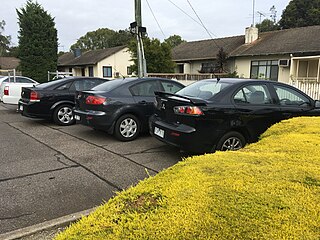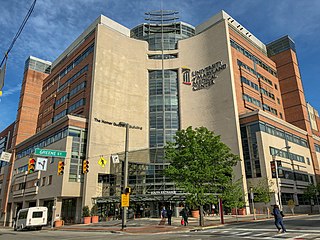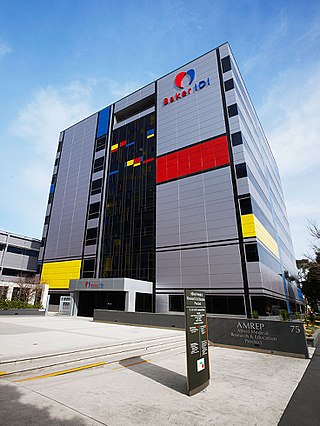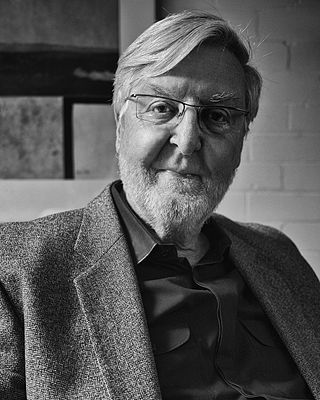
Heidelberg is a suburb of Melbourne, Victoria, Australia, 11 kilometres (7 mi) northeast of Melbourne's central business district, located within the City of Banyule local government area. Heidelberg recorded a population of 7,360 at the 2021 census.

Heidelberg West is a suburb of Melbourne, Victoria, Australia, 10 km north-east of Melbourne's Central Business District, located within the City of Banyule local government area. Heidelberg West recorded a population of 5,252 at the 2021 census.

Monash Medical Centre (MMC) is a teaching hospital in Melbourne, Australia. It provides specialist tertiary-level healthcare to the Melbourne's south-east.

St Vincent's Hospital is a major hospital in Fitzroy, Melbourne, Australia.

The Royal Melbourne Hospital (RMH), located in Parkville, Victoria, an inner suburb of Melbourne, is one of Australia's leading public hospitals. It is a major teaching hospital for tertiary health care with a reputation in clinical research. The hospital is managed as part of Melbourne Health which comprises the Royal Melbourne Hospital, North West Dialysis Service and North Western Mental Health. The Royal Melbourne Hospital appointed Professor Shelley Dolan as the new Chief Executive following an international search. She succeeded Professor Christine Kilpatrick AO, who stepped down on 30 June 2023.

The Royal Children's Hospital (RCH), colloquially referred to as the Royal Children’s, is a major children's hospital in Parkville, a suburb of Melbourne, Victoria, Australia. Regarded as one of the great children’s hospitals globally, the hospital and its facilities are internationally recognised as a “leading centre for paediatrics”. The hospital serves the entire states of Victoria, and Tasmania, as well as southern New South Wales and parts of South Australia.

The Peter MacCallum Cancer Centre, also known as the Peter MacCallum Cancer Institute and commonly abbreviated as Peter Mac, is an Australian oncology research institute, cancer treatment and professional oncologist training centre located in Melbourne, Victoria. The centre is named in honour of Sir Peter MacCallum. Since June 2016, the centre has been located within the Victorian Comprehensive Cancer Centre (VCCC) in Parkville.

Epworth HealthCare is a provider of acute medical, surgical and rehabilitation services in Melbourne, Australia. The group has four divisions: Epworth Richmond, Epworth Eastern, Epworth Cliveden, Epworth Freemasons and Epworth Geelong Epworth Rehabilitation, with rehabilitation sites at Richmond, Camberwell, Brighton and Geelong, Victoria. With over 1,200 beds and more than 7,000 staff, Epworth HealthCare is Victoria's largest not-for-profit private hospital group.

Faculty of Medicine, Dentistry and Health Sciences is the largest faculty of University of Melbourne, with the most post-graduate students, and also hosts the most school departments and centres of all University of Melbourne Faculties, consisting of 52 faculty sub-organisations. In 2021, Melbourne Medical School was ranked 25th in the world and second in Australia in the 2021 QS Subject Rankings.

The University Hospital Geelong, formerly the Geelong Hospital, is an Australian public hospital located in Ryrie Street, Geelong, Victoria. The hospital is part of Barwon Health, Victoria's largest regional health care provider, which has 21 sites. It is the largest hospital in regional Victoria and the only tertiary hospital outside of the Melbourne Metropolitan area. The site is bounded by Ryrie, Bellarine, Myers, and Swanston Streets.

The University of Maryland Medical Center (UMMC) is a teaching hospital with 806 beds based in Baltimore, Maryland, that provides the full range of health care to people throughout Maryland and the Mid-Atlantic region. It gets more than 26,000 inpatient admissions and 284,000 outpatient visits each year. UMMC has approximately 9,050 employees at the UMMC Downtown Campus, as well as 1,300 attending physicians and 950 resident physicians across the Downtown and the Midtown campuses. UMMC provides training for about half of Maryland's physicians and other health care professionals. All members of the medical staff are on the faculty of the University of Maryland School of Medicine.

The Baker Heart and Diabetes Institute, commonly known as the Baker Institute, is an Australian independent medical research institute headquartered in Melbourne, Victoria. Established in 1926, the institute is one of Australia's oldest medical research organisations with a historical focus on cardiovascular disease. In 2008, it became the country's first medical research institute to target diabetes, heart disease, obesity and their complications at the basic, clinical and population health levels.
Sir Peter John Morris, AC, FRS, FMedSci, FRCP, FRCS was an Australian surgeon and Nuffield professor of surgery at the University of Oxford. Morris was President of the Royal College of Surgeons of England, founder of the Oxford Transplant Centre and director of the Centre for Evidence in Transplantation at the Royal College of Surgeons of England.
St John of God Ballarat Hospital provides hospital care for people living in Ballarat and Western Victoria regions of Australia.

Kenneth William Scarlett OAM is an Australian writer specialising in Australian sculpture. His 1980 publication Australian Sculptors (1980) was the first to present a complete survey of sculpture in Australia. Subsequent publications include Sculpture in Public Gardens (1983), Limited Recall: A Fictional Autobiography (2005), Elgee Park: Sculpture in the Landscape (2010) and monographs on the sculptors John Davis (1989) and Andrew Rogers (2010). He was a contributing editor to Sculpture (magazine) USA for many years and his articles appear regularly in art journals in Australia and overseas.

The Victorian Comprehensive Cancer Centre (VCCC) is a multi-site, multi-disciplinary specialist cancer hospital and research centre located in Melbourne, Victoria, Australia. The VCCC comprises an alliance between The University of Melbourne, the Peter MacCallum Cancer Centre, Melbourne Health, the Walter and Eliza Hall Institute of Medical Research, the Royal Women's Hospital, the Royal Children's Hospital, Western Health, St Vincent's Hospital, Melbourne, Austin Health, and the Murdoch Childrens Research Institute.
Avni Sali, is an Australian professor, surgeon, and academic primarily known for advocating an integrative approach to medicine, combining evidence-based complementary therapies with conventional medicine.
Peter Fook Meng Choong is an Australian doctor and professor who specializes in orthopaedics. He is the Director of Orthopaedics at St. Vincent's Hospital, Melbourne and the Hugh Devine Chair of Surgery at the University of Melbourne. In 2014, he became the first surgeon to perform a 3D-printed heel transplant.

Brendan Murphy is an Australian public servant, health executive and nephrologist who served as the Chief Medical Officer (CMO) of Australia from 4 October 2016 before serving as the Secretary of the Department of Health from 13 July 2020 until his retirement on 6 July 2023.
Bernard McCarthy O'Brien was an Australian microsurgeon who was considered a pioneer in his field.















